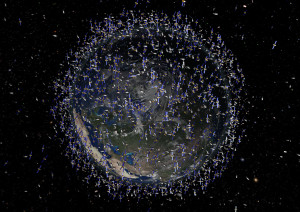This post is written by guest blogger Beth Kelly, a Midwestern freelance writer with a passion for sci-fi and analog photography, as well as all kinds of other outdated and obsolete technology. She graduated from DePaul University with a degree in Art History and Communications in 2011. In the fall she’s moving to Shanghai to teach English. She collects Soviet-era memorabilia and vintage silent movie posters. Find her on Twitter @bkelly_88

Explosive weaponry is a constant presence in film, music, and television. Countless scripts, songs and one-liners have been written about the badass mechanisms we use to wreak havoc upon the world and ourselves. Science fiction in particular is full of imaginative weapons of mass destruction—lasers, particle guns and plasma cannons are wielded by numerous life forms throughout the galaxy, firing searing beams and blasts into the depths of space. Plasma is, however, capable of escaping the realm of fantasy. While it might be most famous for powering the weapons and warp drive on Star Trek, it also might be the answer to some of our most pressing problems here, on planet Earth, particularly when it comes to the accumulation of trash and the ways people, such as ship-breakers in Bangladesh, try to manage it.
Even though Star Trek tells the story of a universe over 200 years into the future, contemporary concerns surrounding animal rights and extinction can be found in the various incarnations of the franchise’s television episodes and films, as well as profound commentary on our responsibility as stewards of the spaces we inhabit.
In Star Trek IV: The Voyage Home, an environmental ethos prevails as the crew comes to terms with the consequences of destructive human behavior. After discovering that humpback whales (now extinct) were imbued with the power to communicate with an alien probe, they must travel back in time to the late 20th century and recover two samples of the species. Another example of “eco-friendly” transmissions could be found in an episode of Star Trek: TNG entitled “Force of Nature.” Over the course of the show it was discovered that at certain high speeds, ships were capable of damaging the spatial continuum. Picard, realizing that his love of exploring the universe may have in fact been harming it, rapidly works to implement rules for warp speeds that won’t damage the fabric of the spatial environment.

Taking a hint from Star Trek and science fiction, some hope plasma might be the key to unlocking our toxic relationship with trash. According to the Environmental Protection Agency, each individual American produces about 4.4 pounds of municipal solid waste (MSW) every single day. In 2012, we generated over 250 million tons of waste, and that number has been climbing ever since. Into landfills go everything from our clothes to our appliances, our rotten apple cores to our dusty Gameboy cartridges—300,000,000,000 pounds of items that we no longer use. About 12 percent of that trash makes its way back into the energy cycle via a waste-to-energy (WTE) plant, but plasma, an ionized gas with no electrical charge found in both nuclear fusion reactors and stars, has another trick up its sleeve.
Plasma gasification plants transform trash from “waste” into usable commodities such as “syngas,” a synthetic, hydrogen-carbon monoxide mixture burned to produce electricity. While most “renewable” power providers looking for alternatives to fossil fuel, such as Columbia Gas of Ohio or Elon Musk’s Solar City, continue to devour the Earth’s resources in some capacity, plasma succeeds in helping us re-use what we’ve already consumed. Plasma provides a transition from traditional “waste management,” or the landfill model, and moves us towards a more sustainable and productive method of disposing used materials.

British Airways recently made headlines with the announcement of its commitment to power planes with MSW by 2017—the first project to attempt to convert trash to airline fuel. Analyses indicate that using this type of gasification process could reduce greenhouse gas emissions by up to 95 percent in comparison to fossil fuels. “What we get from that is a very pure, high-quality fuel,” said Jonathon Counsell, head of environment for British Airways. A number of U.S. airliners have signed a letter of intent to work with Solena Fuels, the company behind British Airway’s plasma gasification technology plans. We can hope that American airlines will pick up with plasma wherever British Airways leaves off.
The plasma waste utilization method occurs within a closed system, releasing zero waste remnants, toxic gases or particulate matter into the environment. Plasma technology allows for very hot plasma to melt all types of waste—metals, silicon, toxic materials—into a non-toxic dross. Biological and chemical compounds, plastic, and toxic gases completely dissociate into simple gases, primarily hydrogen and carbon dioxide. Regained metals are returned to metallurgic industry, slag reincorporated into road construction materials, and non-toxic gases utilized for fuel and energy production. Atom by atom, our trash can be rearranged back into something useful.

Without the emission of harmful ash and terrible odors (as are typically found at incinerating plants), plasma is a remarkable solution for waste disposal—one of our most immediate environmental concerns. But planet Earth is not the only environment suffering from pollution. Scientists have estimated that there are approximately 29,000 objects 10 cm or larger orbiting Earth. Only 7 percent of this debris are working satellites; the rest fall under the broad umbrella of “space junk”, a dangerous potpourri of defunct objects hurtling around the planet at speeds up to 17,500 mph. At these speeds even the smallest piece of debris can be incredibly dangerous. Scientists are already seeing proof of the Kessler Syndrome and are racing to find solutions to the problem, but international cooperation is needed to move forward with any of their audacious plans. For now, the best plan might still be to give Quark a call.
Star Trek’s ecological morals, though sometimes hidden beneath layers of complex storyline, Spock ears, and sci-fi humor, serve to send us Earth-bound individuals an important message. While our resources may be limited, creativity is not. If plasma can’t solve our perilous trash problem, we’re the only ones responsible for coming up with a better solution.
